| |
|
Xiamen Oil Paintings, Wholesale Direct!
|
|
100% hand painted, 100% cotton canvas, 100% money back if not satisfaction. |
|
|
|
|
ART WORKS INDEX
A
B
C
D
E
F
G
H
I
J
K
L
M
N
O
P
Q
R
S
T
U
V
W
X
Y
Z
|
|
ARTISTS INDEX
A
B
C
D
E
F
G
H
I
J
K
L
M
N
O
P
Q
R
S
T
U
V
W
X
Y
Z
|
|
|
|
|
|
|
|
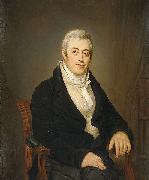 |
Louis Moritz
|
|
painted Portrait of Jonas Daniël Meijer (1780-1834), jurist. in 1800-1834
|
|
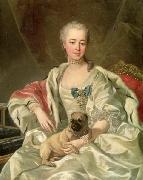 |
Louis Michel van Loo
|
|
Louis-Michel van Loo (2 March 1707-20 March 1771) was a French painter.
He studied under his father, the painter Jean-Baptiste van Loo, at Turin and Rome, and he won a prize at the Academie Royale de Peinture et de Sculpture in Paris in 1725. With his uncle, the painter Charles-Andre van Loo, he went to Rome in 1727 - 1732, and in 1736 he became court painter to Philip V of Spain at Madrid, where he was a founder-member of the Academy in 1752. He returned to Paris in 1753, and painted many portraits of Louis XV of France. In 1765 he succeeded Charles-Andre as director of the special school of the French academy known as the Ecole Royale des Eleves Proteges. In 1766 he made the portrait of the Portuguese statesman Sebastiao de Melo, Marquis of Pombal.
Among his brothers were the painters Francois van Loo (1708 - 1732) and Charles-Amedee-Philippe van Loo (1719 - 1795).
|
|
 |
Louis Michel Eilshemius
|
|
(February 4, 1864 - December 29, 1941) was an American painter, primarily of landscapes and nudes. Although he was academically trained, much of his work has the unself-aware character of naive art. Eilshemius was a grandson of Swiss painter Louis-Leopold Robert.
Born near Newark, New Jersey into a wealthy family, his earliest education was in Europe, after which he spent two years at Cornell University before his art studies began at the Art Students League of New York. He subsequently studied under Bouguereau at the Academie Julian in Paris, and traveled widely in Europe, Africa and the South Seas, returning to the family brownstone in New York City where he was to live for the rest of his life.
|
|
 |
louis masreliez
|
|
Louis Masreliez (Adrien Louis Masreliez) född 1748 i Paris död 19 mars 1810, var en svensk målare, tecknare, grafiker och inredningsarkitekt.
Han var äldre bror till ornamentsbildhuggaren Jean Baptiste Masreliez och son till Jacques Adrien Masreliez, också han en ornamentsbildhuggare, som kallats till Sverige från Frankrike för att medverka vid uppförandet av Stockholms slott. Jacques Adrien Masreliez grundade således konstnärssläkten Masreliez i Sverige.
Louis Masreliez kom till Sverige 1753. Han började sin utbildning vid Ritarakademien vid 10 års ålder. Vid ritarakademien saknades utbildning i måleri, varför Masreliez inledde studier vid Lorens Gottmans verkstad. 1769 tilldelades han ett statligt studiestipendium som han använde till en studieresa till Paris och Bologna. 1773 lämnade han Bologna och bosatte sig i Paris, där han bodde under åtta år. Han återvände till Sverige 1782, där han blev ledamot av Konstakademien och året därpå professor i historiemåleri. Han blev rektor för akademien 1802 och direktör 1805.
Till hans genombrottsverk räknas Gustav III:s paviljong i Hagaparken
|
|
|
|
 |
louis marcoussis
|
|
Louis Marcoussis, formerly Ludwik Kazimierz Wladyslaw Markus or Ludwig Casimir Ladislas Markus, (1878 or 1883, Warsaw -- October 22, 1941, Cusset) was a painter and engraver of Polish origin who lived in Paris for much of his life and became a French citizen.
After studying law briefly in Warsaw he went to the Krakow Academy of Fine Arts, where his teachers included Jan Stanislawski and Jozev Mehoffer. Moving to Paris in 1903, he spent a short time at the Academie Julian under Jules Lefebvre. The first time a painting of his was shown in a major exhibition was at the Salon d'Automne in 1905, and over the next quarter-century his work was shown in many other important exhibitions, in particular at the Salon des Independants and the Tuileries.
He drew cartoons for satirical journals, as he had earlier in Poland. In Paris he needed to earn his own living, and also took on other drawing and illustration work. In the cafes of Montmartre and Montparnasse he got to know Apollinaire, Braque, Degas, Picasso and many more artists and writers. It was Apollinaire who suggested Markus' French name, Marcoussis, after a village not far from Paris.
Impressionism influenced his early paintings, but from about 1910 he was part of the Cubist movement alongside other avant-garde painters like Picasso, Braque and Juan Gris. His work was shown in exhibitions in many European cities and in the US. In 1925 he had his first solo exhibition in Paris. As well as painting still-lifes and musical instruments in the Cubist manner, he also produced portraits, views of Paris, and images from the Breton seaside.
From 1930 onwards, he concentrated on printmaking and illustration, including work inspired by Apollinaire's Alcool, Tzara's Indicateur des chemins de cœur, and Éluard's Lingeres legeres and Aurelia. In the late 1930s Marcoussis collaborated with Spanish surrealist Joan Mire and taught him etching techniques. He also taught at the Academie Schlaefer.
In 1913 he had married Alice Halicka, a painter who came from Krakow. Their daughter Malene was born in 1922. Marcoussis served in a Polish company of the French Foreign Legion from 1914-1919. He became a French citizen, while also staying in touch with Poland, both personally and professionally. He did not generally talk about his Jewish ancestry, and his family had converted to Catholicism, but today Marcoussis is often described as a Jewish artist.
After Nazi troops arrived in Paris in 1940, Marcoussis and Alice moved to Cusset near Vichy. He died there on 22 October 1941
|
|
 |
Louis Loeb
|
|
Landscape, Portrait, Figure-idylls
American 1866-1909
|
|
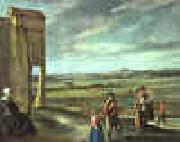 |
Louis Le Nain
|
|
1593-1648
French
Louis Le Nain Gallery
French family of painters. Antoine Le Nain (b Laon, c. 1600; bur Paris, 26 May 1648) and his brothers Louis Le Nain (b Laon, c. 1600; bur Paris, 24 May 1648) and Mathieu Le Nain (b Laon, c. 1607; bur Paris, 26 April 1677) lived together and shared a studio in Paris. Since the studio was headed by Antoine, he is assumed to have been older than Louis. The brothers reputation rests on a number of paintings signed Le Nain, on the basis of which other paintings (but no drawings) have also been attributed to them. None of the signed paintings bears a Christian name, and there is no secure way of attributing works to the individual brothers, although many attempts have been made. Eighteenth-century sale catalogues, fearful of anonymity, effectively chose from the three names at random. Since the writings of Witt (1910) and Jamot (1922) in particular, it has been habitual to ascribe small paintings on copper to Antoine, and austere, larger peasant scenes to Louis. This division of hands will be found in almost all the subsequent literature on the artists, although it must be stressed that there is no evidence at all to support it. Great efforts have also been made to identify works by Mathieu, since he survived his brothers by nearly 30 years and presumably continued to paint after their deaths in 1648. However, no such activity after 1648 is securely documented, and none of the surviving works bears a date later than 1647; and the arguments for a separate Mathieu oeuvre, though cogent, should not be regarded as conclusive. The outstanding feature of the work of the Le Nain brothers, and the basis of their celebrity since the mid-19th century, is the artists treatment of the poor.
|
|
 |
Louis Lcart
|
|
French (1880-1950)
Louis Icart was born in Toulouse, France. He began drawing at an early age. He was particularly interested in fashion, and became famous for his sketches almost immediately. He worked for major design studios at a time when fashion was undergoing a radical change-from the fussiness of the late nineteenth century to the simple, clingy lines of the early twentieth century. He was first son of Jean and Elisabeth Icart and was officially named Louis Justin Laurent Icart. The use of his initials L.I. would be sufficient in this household. Therefore, from the moment of his birth he was dubbed 'Helli'. The Icart family lived modestly in a small brick home on rue Traversi??re-de-la-balance, in the culturally rich Southern French city of Toulouse, which was the home of many prominent writers and artists, the most famous being Henri de Toulouse-Lautrec.
Icart fought in World War I. He relied on his art to stem his anguish, sketching on every available surface. It was not until his move to Paris in 1907 that Icart would concentrate on painting, drawing and the production of countless beautiful etchings, which have served (more than the other mediums) to indelibly preserve his name in twentieth century art history. When he returned from the front he made prints from those drawings. The prints, most of which were aquatints and drypoints, showed great skill. Because they were much in demand, Icart frequently made two editions (one European, the other American) to satisfy his public. These prints are considered rare today, and when they are in mint condition they fetch high prices at auction.
Art Deco, a term coined at the 1925 Paris Exposition des Arts Decoratifs, had taken its grip on the Paris of the 1920s. By the late 1920s Icart, working for both publications and major fashion and design studios, had become very successful, both artistically and financially. His etchings reached their height of brilliance in this era of Art Deco, and Icart had become the symbol of the epoch. Yet, although Icart has created for us a picture of Paris and New York life in the 1920s and 1930s, he worked in his own style, derived principally from the study of eighteenth-century French masters such as Jean Antoine Watteau, François Boucher and Jean Honor?? Fragonard.
In Icart's drawings, one sees the Impressionists Degas and Monet and, in his rare watercolors, the Symbolists Odilon Redon and Gustave Moreau. In fact, Icart lived outside the fashionable artistic movements of the time and was not completely sympathetic to contemporary art. Nonetheless, his Parisian scenes are a documentation of the life he saw around him and they are nearly as popular today as when they were first produced.
In 1914 Icart had met a magical, effervescent eighteen-year-old blonde named Fanny Volmers, at the time an employee of the fashion house Paquin. She would eventually become his wife and a source of artistic inspiration for the rest of his life.
|
|
|
|
|
|
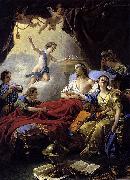 |
Louis Jean Francois Lagrenee
|
|
(December 30, 1724 - June 19, 1805) was a French painter, a pupil of Carlo Vanloo. His younger brother Jean-Jacques Lagren??e was also a painter.
Lagrenee was born in Paris. In 1755 he became a member of the Royal Academy, presenting as his diploma picture the Rape of Deianira (Louvre). He visited Saint Petersburg at the call of the empress Elizabeth, and on his return was named in 1781 director of the French Academy in Rome, a position he kept until 1787. He there painted the Indian Widow, one of his best-known works.
In 1804 Napoleon conferred on him the cross of the l??gion d'honneur, and on June 19, 1805 he died in the Louvre, of which he was honorary keeper.
|
|
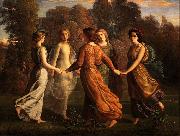 |
Louis Janmot
|
|
(21 May 1814 - 1 June 1892) was a French painter and poet.
Janmot was born in Lyon of Catholic parents who were deeply religious. He was extremely moved by the death of his brother in 1823 and his sister's in 1829. He became student at the Royal College of Lyon where he met Frederic Ozanam and other followers of his philosophy professor, Abbe Noirot. In 1831 he was admitted to the École des Beaux-Arts de Lyon and a year later, he won the highest honor, the Golden Laurel. In 1833, he came to Paris to take painting lessons from Victor Orsel and Jean-Auguste-Dominique Ingres. With other Lyon painters, he entered the Society of St. Vincent de Paul. In 1835, he went to Rome with Claudius Lavergne, Jean-Baptiste Frenet and other students and met Hippolyte Flandrin.
After his come back to Lyon in 1836, Janmot would attract the attention of critics of the Salon de Paris in conducting large-scale paintings with religious inspiration such as The Resurrection of the son of the widow of Nain (1839) or Christ in Gethsemane (1840). After 1845, he attracted the interest of Charles Baudelaire with his painting Flower of the Fields that allowed him to access to the Salon of 1846. Theophile Gautier was impressed by his Portrait of Lacordaire (1846). But the failure of his Poem of the Soul at the Universal Exhibition of 1855 disappointed him. In December of that year he married Leonie Saint-Paulet, from a noble family in Carpentras.
In 1856, Janmot obtained a commission to paint a fresco (since destroyed) representing the Last Supper for the church of St. Polycarp. Other orders followed, including the decoration of the dome of the Church of St. Francis de Sales and for the town hall that had been renovated by his friend the architect T. Desjardins. He was then appointed professor at the École des Beaux-Arts.
|
|
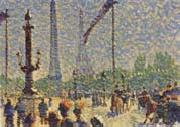 |
Louis Hayet
|
|
French, 1864-1940.French painter and writer. He was largely self-taught and initially earned his living as an itinerant painter-decorator. In 1881 he met Lucien and Camille Pissarro while painting landscapes near Pontoise and through them met Paul Signac in 1885 and Seurat in 1886. After a years military service at Versailles, Hayet moved to Paris in the autumn of 1887. There he began to apply to his paintings Eug?ne Chevreuls theories of colour contrast with which he had become familiar by 1881. A gifted watercolour painter, he also experimented with the ancient technique of wax encaustic, painting on a prepared cotton that allowed light to filter through. The paint surface of works such as The Grange (Beauchamp, France, priv. col., see 1983 Pontoise exh. cat., no. 1) retains a vivid tonal freshness, while the subject of crowds of peasants gathered before the Paris agricultural market reveals a debt to Pissarro. During the second half of the 1880s he became obsessed with the notion of passage
|
|
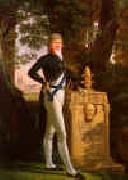 |
Louis Gauffier
|
|
1762-1801
French
Louis Gauffier Gallery
French painter. Following his move to Paris, where he became a pupil of Hugues Taraval and a student at the Academie Royale, in 1784 Gauffier shared the Prix de Rome with Jean-Germain Drouais and Antoine-Denis Chaudet (for sculpture), his own work being Christ and the Woman of Canaan (Paris, Ecole N. Sup. B.-A.). During his time in Rome (1785-9) Gauffier worked hard, but his health was poor and the results variable. On his return to Paris he was accepted (agree) by the Academie as a history painter. Soon after, he returned to Rome in order to escape the worsening situation in Revolutionary Paris, although he continued to send his Neo-classical works to the Salon. In March 1790 he married Pauline Chatillon (d July 1801), a portrait painter whom he and Drouais had taught..
|
|
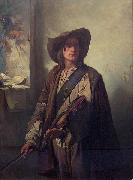 |
Louis Gallait
|
|
(9 or 10 May 1810 - 20 November 1887) was a Belgian painter. His d his reputation especially with the large painting of Charles V's abdication. Gallait's works were considered as the basis for a desirable renewal of historical paintings because of the realism, costume faithfulness and colorful posture of his paintings. His last artwork was sent on tour in Germany and that led to new signals even among German historians. He was also a distinguished portrait painter.
Gallait died in Brussels in 1887. There is a painting by Louis Gallait at the Norton Art Museum in West Palm Beach, Florida ("Art and Liberty").
|
|
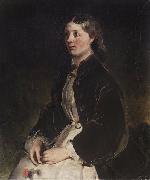 |
Louis Ferdinand von Rayski
|
|
Ferdinand von Rayski (1806 - 1890) was a German painter noted for his portraits.
Rayski was born in 1806 in Pegau. From 1816 to 1821 he studied drawing under Traugott Faber at the Freimaurerinstitut in Dresden and from 1823 to 1825 studied at Kunstakademie in Desseldorf. He began his career as a professional artist in 1829, painting portraits of his noble relatives in Hannover and Silesia. From 1831 to 1834 he lived in Dresden, where he received numerous portrait commissions. He traveled to Paris in 1834-35, and was influenced by the works of Delacroix, Gericault and Gros. Rayski gained a reputation as a distinguished portrait painter, but also produced animal and hunting scenes, as well as, yet less frequently, military, historical and mythological paintings. He lived in Dresden from 1840 until his death in 1890.
|
|
|
|
 |
Louis Eysen
|
|
1843 - 1899
German painter and engraver. His family, which had moved to England in the 1840s, returned to Frankfurt am Main in 1850. He studied wood engraving with Alexander Stix (1819-93) at the St?delsches Kunstinstitut in Frankfurt and later achieved considerable success in this medium (e.g. Glade, 1868; see Zimmermann, p. 9). He was taught painting by Karl Hausmann (1825-86) and was influenced chiefly by contemporary French art. He first worked mainly in Berlin and then in Munich, where he met Otto Scholderer and Wilhelm Leibl, who painted his portrait (c. 1870; Frankfurt am Main, Stedel. Kstinst.). He studied with Leon Bonnat in Paris from 1869 to 1870. In 1873 he settled at Kronberg,
|
|
|
|
 |
Louis Eilshemius
|
|
1864-1941
Louis Eilshemius Gallery
Born near Newark, New Jersey into a wealthy family, his earliest education was in Europe, after which he spent two years at Cornell University before his art studies began at the Art Students League of New York. He subsequently studied under Bouguereau at the Acad??mie Julian in Paris, and traveled widely in Europe, Africa and the South Seas, returning to the family brownstone in New York City where he was to live for the rest of his life.
His early landscapes, which show the influence of the Barbizon school and of Corot, George Inness and Albert Pinkham Ryder, gained him little recognition from critics or from the public. Around 1910, the element of fantasy in his work became more pronounced and his technique became coarser; henceforth, he often painted on cardboard instead of canvas. As his works became more idiosyncratic, so did his behavior, and he developed an unsettling habit of visiting galleries and loudly condemning the works on display.
His later, visionary works depicting moonlit landscapes populated with voluptuous nymphs caused his contemporaries particular consternation, due to their crudely rendered and often extravagantly smiling nudes. These are shown frolicking in forests or waterfalls, either alone or in groups, sometimes defying gravity by floating through the air. His paintings of New York rooftops are as lyrical as his pastoral scenes, and like them are often bounded by sinuous "frames" he painted onto his pictures.
Eilshemius also wrote verse and prose, composed music, painted, philosophized and became notorious for his numerous, often vitriolic, letters-to-the-editor of various New York City publications. His lack of public acclaim led him to desperate measures: suspecting that the length of his name was responsible for his neglect, in about 1890 he began signing his paintings "Elshemus" (he reverted back to the original spelling in 1913). On letterheads and in hyperbolic, self-published flyers he would proclaim his accomplishments: "Educator, Ex-actor, Amateur All-around Doctor, Mesmerist-Prophet and Mystic, Reader of Hands and Faces, Linguist of 5 languages", as well as world-class athlete and marksman, "Spirit-Painter Supreme", and musician whose improvisations rivalled the compositions of Chopin. All of this only reinforced the impression, already suggested by the peculiar imagery in many of his paintings, that he was either mad or a charlatan.
He was not without supporters, however. He was championed by Marcel Duchamp, who "discovered" Eilshemius in 1917 and invited him to exhibit with him in Paris that year. His work was generally well received by French viewers and critics; his admirers included Matisse. Duchamp subsequently helped to arrange Eilshemius's first solo exhibition in 1920, at the Soci??t?? Anonyme in New York City. The hostile critical reception to this exhibition, however, finally drove him to give up painting entirely in 1921, although there is a single known painting dated 1937. The remainder of his life was dedicated to self-promotion, and in 1931 he took to referring to himself as "Mahatma".
Injured in an automobile accident in 1932, he became increasingly reclusive. His health in decline and his family fortune spent, he died in 1941.
Since his death, Eilshemius's work has found a wider audience. One of the artist's few consistent patrons, Roy Neuberger, donated a large body of Eilshemius' work to the Neuberger Museum of Art located at SUNY Purchase College in New York State.
|
|
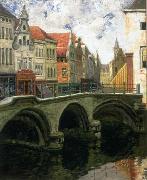 |
Louis Dewis
|
|
(1872-1946) was a Belgian Post-Impressionist painter, who lived most of his adult life in France.
Dewis was born Isidore Louis Dewachter in Mons, Belgium, the son of Isidore Louis Dewachter and Eloise Desmaret Dewachter. He spent his formative years in Liege where his closest boyhood friend was Richard Heintz (fr:Richard Heintz) (1871-1929), who also became an internationally known landscape artist.
Although the name "Dewachter" may have Flemish roots, Dewachter always considered himself a Walloon.
|
|
 |
Louis de Silvestre
|
|
(23 June 1675 - 11 April 1760) was a French portrait and history painter. He was court painter to King Augustus II of Poland, and director of the Royal Academy of Arts in Dresden.
Sylvestre was born in Sceaux, south of Paris, the third son of Israel Silvestre, the notable engraver and drawing-master to the Dauphin himself. Louis was taught initially by his father, then trained under Charles Le Brun and Bon Boullogne; he completed his studies in Rome, where he met Carlo Maratta, whose work had a great influence on him.
After his return to Paris, Sylvester entered the Royal Academy in 1702 and was appointed professor in 1706.
|
|
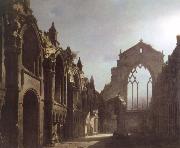 |
louis daguerre
|
|
Louis-Jacques-Mand?? Daguerre (November 18, 1787 ?C July 10, 1851) was a French artist and chemist, recognized for his invention of the daguerreotype process of photography.
Daguerre was born in Cormeilles-en-Parisis, Val-d'Oise, France. He apprenticed in architecture, theater design, and panoramic painting. Exceedingly adept at his skill for theatrical illusion, he became a celebrated designer for the theater and later came to invent the Diorama, which opened in Paris in July 1822.
In 1827, Joseph Nic??phore Ni??pce produced the world's first permanent photograph (known as a Heliograph). Daguerre partnered with Ni??pce two years later, beginning a four-year cooperation. Ni??pce died suddenly in 1833. The main reason for the "partnership", as far as Daguerre was concerned, was connected to his already famous dioramas. Niepce was a printer and his process was based on a faster way to produce printing plates. Daguerre thought that the process developed by Niepce could help speed up his diorama creation.
Daguerre announced the latest perfection of the Daguerreotype, after years of experimentation, in 1839, with the French Academy of Sciences announcing the process on January 7 of that year. Daguerre's patent was acquired by the French Government, and, on August 19, 1839, the French Government announced the invention was a gift "Free to the World."
Daguerre and Ni??pce's son obtained a pension from the Government in exchange for freely sharing the details of the process. Daguerre died in Bry-sur-Marne, 12 km from Paris. A monument marks his grave there.
|
|
 |
Louis D. Fancher
|
|
December 25, 1884-March 2, 1944) was an American artist and illustrator, notable for his drawings that appeared in books, in magazines, and on propaganda posters during World War.
Fancher was born in Minneapolis, Minnesota in 1884 and was a student of Henry Siddons Mowbray, Robert Henri, and Kenyon Cox. He was active in San Francisco as well as in New York, where he lived most of his life.
|
|
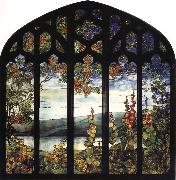 |
Louis Comfort Tiffany
|
|
American Art Nouveau Stained Glass Artist, 1848-1933
was an American artist and designer who worked in the decorative arts and is best known for his work in stained glass and is the American artist most associated with the Art Nouveau and Aesthetic movements. Tiffany was affiliated with a prestigious collaborative of designers known as the Associated Artists which included Lockwood de Forest, Candace Wheeler, and Samuel Colman. Tiffany designed stained glass windows and lamps, glass mosaics, blown glass, ceramics, jewelry, enamels and metalwork Louis was the son of Charles Lewis Tiffany, founder of Tiffany and Company; and Harriet Olivia Avery Young. Louis married Mary Woodbridge Goddard (c1850-1884) on May 15, 1872 in Norwich, Connecticut and had the following children: Mary Woodbridge Tiffany (1873-1963) who married Graham Lusk; Charles Louis Tiffany I (1874-1874); Charles Louis Tiffany II (1878-1947); and Hilda Goddard Tiffany (1879-1908). After the death of his wife, he married Louise Wakeman Knox (1851-1904) on November 9, 1886. They had the following children: Louise Comfort Tiffany (1887-1974); Julia DeForest Tiffany (1887-1973) who married Gurdon S. Parker then married Francis Minot Weld; Annie Olivia Tiffany (1888-1892); and Dorothy Trimble Tiffany (1891-1979). Many of Tiffany's descendants are active in the arts, politics, and the sciences. Only one descendant is working in glass today- Dr. Rodman Gilder Miller of Seattle, WA,
|
|
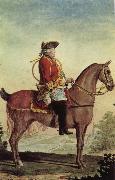 |
Louis Carrogis Carmontelle
|
|
August 15, 1717?CDecember 26, 1806,was a French dramatist, painter and architect; author of little pieces under the name of Proverbes.
|
|
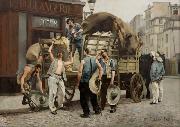 |
Louis Carrier-Belleuse
|
|
(1848-1913) was a French painter and sculptor.
He was son and pupil of Albert-Ernest Carrier-Belleuse. He designed the patterns of the Faïencerie (earthenware factory) from Choisy-le-Roi, where he was artistic director. He was also the sculptor of the Equestrian monument to General Manuel Belgrano
|
|
 |
Louis Caravaque
|
|
Louis Caravaque, a French portrait painter, was a native of Gascony. He went to Russia, and in 1716 painted at Astrakhan the portrait of Peter the Great, which has been engraved by Massard and by Langlois. He again painted the Czar in 1723, and subsequently the Empresses Anne and Elizabeth. He died in Russia in 1752.
|
|
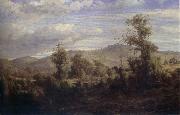 |
Louis Buvelot
|
|
Swiss-born Australian Painter
1814-1888
was a Swiss-born landscape painter who emigrated to Australia in 1865 and influenced the Heidelberg School of painters. Buvelot was born in Morges, Vaud, Switzerland, second son of Francois Simeon Buvelot, postal official, and his wife Jeanne-Louise nee Heizer, a school teacher. Louis Buvelot worked under Marc-Louis Arland at Lausanne, and from around 1834 continued his studies at Paris with Camille Flers, a well-known landscape painter of the day. After a few months there he migrated to Bahia, Brazil where he worked on his uncle's coffee plantation. In October 1840 Buvelot moved to Rio de Janeiro and attracted the notice of the emperor Dom Pedro II, who bought some of his pictures and decorated him with the Order of the Rose. In November 1843 Buvelot married Marie-Felicite, nee Lalouette (born 1816). Buvelot returned to Switzerland in 1852 and in 1856 was awarded a silver medal for a picture exhibited at Berne.
|
|
|
|
|
|
|
|
 |
Louis Anquetin
|
|
1861-1932,French painter. He came to Paris in 1882 and studied art at the Ateliers of Bonnat and Cormon, where he was a contemporary and friend of Henri de Toulouse-Lautrec, Emile Bernard and Vincent van Gogh. His early work shows the influence of Impressionism and of Edgar Degas. In 1887 Anquetin and Bernard devised an innovative method of painting using strong black contour lines and flat areas of colour; Anquetin aroused much comment when he showed his new paintings, including the striking Avenue de Clichy: Five O'Clock in the Evening (1887; Hartford, CT, Wadsworth Atheneum) at the exhibition of Les XX in Brussels and at the Salon des Independants in Paris in 1888. The new style, dubbed Cloisonnisme by the critic Edouard Dujardin (1861-1949), resulted from a study of stained glass, Japanese prints and other so-called 'primitive' sources; it was close to the Synthetist experiments of Paul Gauguin and was adopted briefly by van Gogh during his Arles period. Anquetin's works were shown alongside Gauguin's and Bernard's at the Caf? Volpini exhibition in 1889,
|
|
|
|
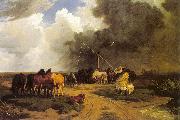 |
Lotz, Karoly
|
|
Hungarian Painter, 1833-1904
was a German-Hungarian painter. Karl Lotz was born in Bad Homburg vor der Höhe, Germany, the seventh and youngest surviving child of Wilhelm Christian Lotz and Antonia Höfflick. His father was a valet of Prince Gustav zu Hessen-Homburg at the time when the prince was representing Austria at the Congress of Vienna, which among other matters dealt with the House of Hessen-Homburg's rights of sovereignty over Hessen-Darmstadt. The sudden death of the young Baron von Sinclair, charge d'affaires, forced W. C. Lotz temporarily into the rôle. While in Hungary in 1815 he made the acquaintance of the 13-year-old Antonie Hoefflich, whom he married three years later. She gave birth to eight children, of whom Karl was the youngest. W. C. Lotz died in 1837 and Antonie moved the family to Pest (now that part of Budapest to the north of the River Danube). Karl attended the Piaristengymnasium, where, although Calvinist, he was awarded a scholarship for his exceptional academic performance. He began his artistic career as a pupil of the Hofkapellmeister Destouches, then in the academy of the Venetian master Jacopo Marastoni (1804-1860). Later he was a pupil of the historical painters Henrik Weber (1818-1866) in Budapest and Carl Rahl (1812-1865) in Vienna. Together with Rahl he worked on numerous commissions. Later he started on his own original works, first as a romantic landscape artist in scenes of the Alföld (the Hungarian lowland plain), and then as a creator of monumental murals and frescos in the style of the Venetian master Tiepolo. After various works in Budapest he became active in Vienna. He laid out plans for a grandiose palace, and completed murals commissioned by the Abbot of Tihany for his abbey church on the shore of Lake Balaton. He became known for his portraits and nudes, for which both his wife and his daughters (Katarina in particular) posed. Lotz found married bliss only at the age of 58, when he married the widow Jacoboy, the former wife of his brother Paul Johann Heinrich, who had died in 1828. From then on he signed his works Keroly Jacoboy-Lotz. In 1882 Lotz was appointed Professor at various art academies in Budapest, and in 1885 he became dean of a newly-established department for women painters.
|
|
 |
LOTTO, Lorenzo
|
|
Italian High Renaissance Painter, ca.1480-1556
Italian painter and draughtsman. He had a long and often prosperous career as a painter, and, although he travelled widely, his style retained a close affinity with the paintings of his native Venice. He was one of an outstanding generation of painters, including Giorgione, Titian, Palma Vecchio and Pordenone, who appeared in Venice and the Veneto during the first decade of the 16th century. In comparison with his contemporaries, Lotto was a fairly traditional painter in that he worked primarily in the long-established genres of altarpieces, devotional pictures and portraiture. Such paintings were popular in the Venetian provinces and the Marches where Lotto spent much of his career and where he often received more money for his commissions than he could obtain in Venice. His most important commissions were for altarpieces, and he is perhaps best known for a series of sacre conversazioni in which he skilfully varied the symmetrical groupings of figures found in earlier Venetian treatments of the subject by Giovanni Bellini and Alvise Vivarini. Precedents in Venice were also important for Lotto's early efforts in bust-length portraiture, but from 1525 he made a considerable contribution to the development of the three-quarter-length portrait. He painted many private devotional paintings but only a few of the historical, mythological or allegorical scenes that were popular in northern Italy in this period. Lotto is one of the best-documented painters of the 16th century: 40 autograph letters dating from 1524 to 1539,
|
|
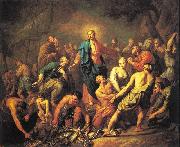 |
Losenko, Anton
|
|
Russian Painter, 1737-1773
Ukrainian painter, active in Russia. He trained (1753-8) under Ivan Argunov, and from 1758 he was a student at the recently founded Academy of Art in St Petersburg, where he later taught. From 1760 to 1769 he spent time in Paris, where he studied at the Acad?mie Royale de Peinture et de Sculpture under Jean Reteux (1692-1768) and Joseph-Marie Vien. He then studied in Rome.
|
|
|
|
|
|
|
|
|
|
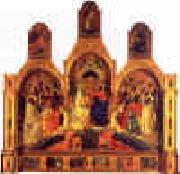 |
Lorenzo Monaco
|
|
Italian
c1370-c1424
Lorenzo Monaco Gallery
was a Florentine painter. He joined the Camaldolese monastery of Santa Maria degli Angeli in Florence in 1391, but he left monastic life before making a lifetime commitment. Despite this fact, he has traditionally been called "Lawrence the Monk." His work shows the influence of the International Gothic style of the late fourteenth century, as well as that of the Sienese school.
|
|
 |
Lorenzo Lotto
|
|
Italian
1480-1556
Lorenzo Lotto Galleries
In this last period of his life, Lorenzo Lotto would frequently move from town to town, searching for patrons and commissions. In 1532 he went to Treviso. Next he spent about seven years in the Marches (Ancona, Macerata en Jesi), returning to Venice in 1540. He moved again to Treviso in 1542 and back to Venice in 1545. Finally he went back to Ancona in 1549.
This was a productive period in his life, during which he painted several altarpieces and portraits :
Santa Lucia before the Judge, 1532, Jesi, Pinacoteca comunale
The Sleeping Child Jesus with the Madonna, St. Joseph and St. Catherine of Alexandria, 1533, Bergamo, Accademia Carrara
Portrait of a Lady as Lucretia, 1533, National Gallery, London.
Holy Family with SS Jerome, Anna and Joachim, 1534, Firenze, Uffizi
Holy Family, ca 1537, Paris, Louvre
Portrait of a Young Man, Firenze, Uffizi
Crucifixion, Monte San Giusto, Church of S Maria in Telusiano
Rosary Madonna, 1539, Cingoli, Church of San Nicolo
Portrait of a Man, 1541, Ottawa, National Gallery of Canada
Bust of a Bearded Man, 1541, ascribed, San Francisco, Fine Arts Museum
The Alms of Saint Anthony, 1542, Venezia, church SS Giovanni e Paolo
Madonna and four Saints, 1546, Venezia, Church of San Giacomo dell??Orio
Portrait of fra?? Gregorio Belo da Vicenza, 1548,New York, Metropolitan Museum
Assumption, 1550, Ancona, church San Francesco alle Scale
The Crossbowman, 1551, Rome, Pinacoteca Capitolina
Portrait of an Old man, ascribed, ca 1552, Saint Petersburg, Ermitage
Presentation in the Temple, 1555, Loreto, Palazzo Apostolico
A Venetian woman in the guise of Lucretia (1533).At the end of his life it was becoming increasingly difficult for him to earn a living. Furthermore, in 1550 one of his works had an unsuccessful auction in Ancona. As recorded in his personal account book, this deeply disillusioned him. As he had always been a deeply religious man, he entered in 1552 the Holy Sanctuary at Loreto, becoming a lay brother. During that time he decorated the basilica of S Maria and painted a Presentation in the Temple for the Palazzo Apostolico in Loreto. He died in 1556 and was buried, at his request, in a Dominican habit.
Giorgio Vasari included Lotto's biography in the third volume of his book Vite. Lorenzo Lotto himself left many letters and a detailed notebook (Libro di spese diverse, 1538-1556), giving a certain insight in his life and work. Among the many painters he influenced are likely Giovanni Busi
|
|
 |
Lorenzo Lippi
|
|
1606-65
Italian painter and poet. He was trained by Matteo Rosselli, with whom he worked for many years in close partnership. His collaboration was sometimes anonymous but is documented from 1622, when they decorated the ceiling of the Sala della Stufa (Florence, Pitti), to 1631-2, when they worked together on lunettes portraying St Francis Adoring the Child and St Catherine in Prison (Florence, S Gaetano). In 1630 Lippi was enrolled in the Accademia del Disegno but appears not to have had his own workshop until after 1634, although he worked independently before then. The earliest paintings attributable to him are, both in facial types and in the soft, rich folds of the drapery, close in style to the work of Rosselli. Examples include canvases of the Apostles James, John and Matthew, and Christ Blessing (all 1628; Vaglia, S Pietro), and the Virgin Handing the Child to St Francis (1629; Florence, S Salvatore di Camaldoli). In the 1630s Lippi painted decorative and theatrical compositions, mainly on literary and biblical themes, which remained indebted to Rosselli, for example Samson and Delilah (1632; Stockholm, Nmus.) and the Virgin in Glory with Saints (1634; Ronta, nr Barberino di Mugello, S Michele). Shortly afterwards he produced works
|
|
|
|
|
|
|
|
|
|
|
|
|
|
|
| Wholesale China Oil Painting Wholesale Oil Painting China Xiamen Portrait Reproduction on canvas Chinese Oil Painting Wholesale USA Oil Painting |
|
|
|
|
|